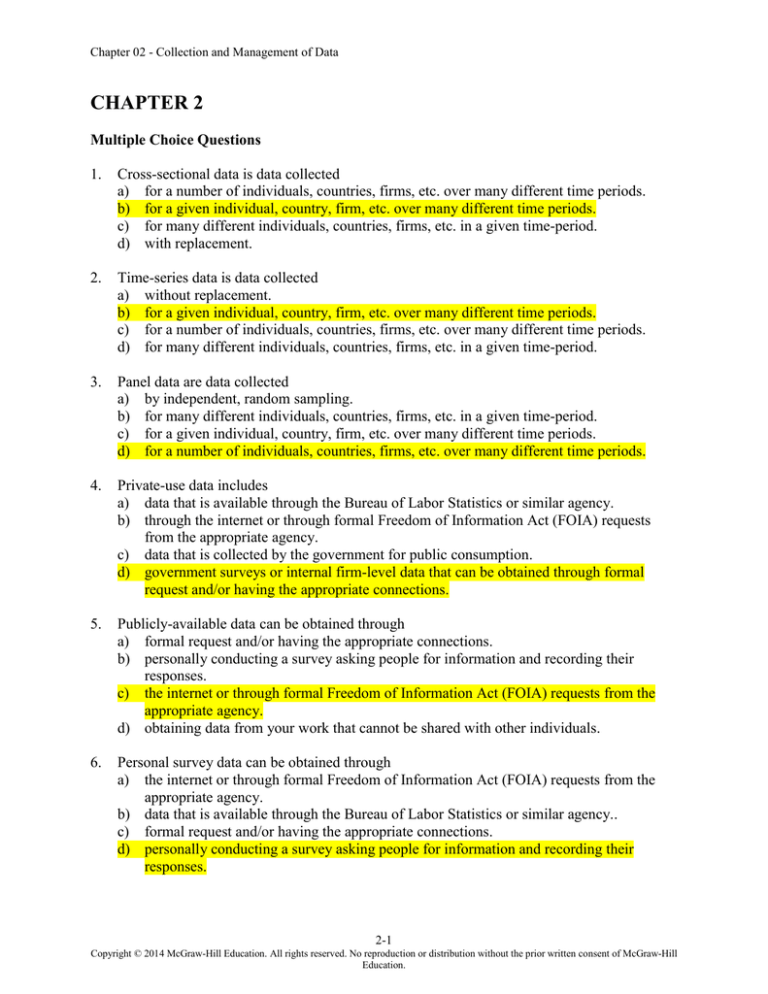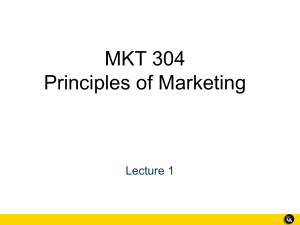
Chapter 02 - Collection and Management of Data
CHAPTER 2
Multiple Choice Questions
1.
Cross-sectional data is data collected
a) for a number of individuals, countries, firms, etc. over many different time periods.
b) for a given individual, country, firm, etc. over many different time periods.
c) for many different individuals, countries, firms, etc. in a given time-period.
d) with replacement.
2.
Time-series data is data collected
a) without replacement.
b) for a given individual, country, firm, etc. over many different time periods.
c) for a number of individuals, countries, firms, etc. over many different time periods.
d) for many different individuals, countries, firms, etc. in a given time-period.
3.
Panel data are data collected
a) by independent, random sampling.
b) for many different individuals, countries, firms, etc. in a given time-period.
c) for a given individual, country, firm, etc. over many different time periods.
d) for a number of individuals, countries, firms, etc. over many different time periods.
4.
Private-use data includes
a) data that is available through the Bureau of Labor Statistics or similar agency.
b) through the internet or through formal Freedom of Information Act (FOIA) requests
from the appropriate agency.
c) data that is collected by the government for public consumption.
d) government surveys or internal firm-level data that can be obtained through formal
request and/or having the appropriate connections.
5.
Publicly-available data can be obtained through
a) formal request and/or having the appropriate connections.
b) personally conducting a survey asking people for information and recording their
responses.
c) the internet or through formal Freedom of Information Act (FOIA) requests from the
appropriate agency.
d) obtaining data from your work that cannot be shared with other individuals.
6.
Personal survey data can be obtained through
a) the internet or through formal Freedom of Information Act (FOIA) requests from the
appropriate agency.
b) data that is available through the Bureau of Labor Statistics or similar agency..
c) formal request and/or having the appropriate connections.
d) personally conducting a survey asking people for information and recording their
responses.
2-1
Copyright © 2014 McGraw-Hill Education. All rights reserved. No reproduction or distribution without the prior written consent of McGraw-Hill
Education.
Chapter 02 - Collection and Management of Data
Short Answer Questions
1.
When working with cross-section data, how do you choose the appropriate unit of
observation? Explain.
2.
Why are data management techniques so important? What is the primary goal of such
techniques? Explain.
3.
Why do we recommend saving one master file while performing calculations in another file?
Explain.
4.
Why do we recommend including a worksheet identifying all data sources used to construct
our master file? Explain.
5.
Why do we suggest making file and variable names as intuitive as possible? Explain.
6.
Why is it potentially valuable to perform calculations in a new worksheet? Explain.
7.
Why must we be careful when merging data from different sources into one file? Explain.
Essay Questions
1.
Why is data collection so important? Explain.
2.
Suppose you have identified a good question of interest and you expect appropriate data to
be available on the internet. What is the first thing that you should do to locate such data?
Explain.
3.
Suppose you have identified a good question of interest but you cannot locate appropriate
data on the internet. What could you do to collect appropriate data? Explain.
2-2
Copyright © 2014 McGraw-Hill Education. All rights reserved. No reproduction or distribution without the prior written consent of McGraw-Hill
Education.
Chapter 02 - Collection and Management of Data
SOLUTIONS
Multiple Choice Questions
1.
2.
3.
4.
5.
6.
B
B
D
D
C
D
Short Answer Questions
1.
Your first concern should be the unit of observation that best addresses your question of
interest. Beyond that, it is always advantageous to choose the unit of observation that offers
the maximum possible number of observations, because doing so will increase the precision
of your estimates.
2.
Data management techniques are important because simple mistakes with data can lead to
hours upon hours of work to reconstruct a data set. The goal of data management is to” (1)
reduce the chances of overwriting existing data, which would require us to spend unwanted
hours re-creating our data from the beginning and (2) provide clear intuition as to our
process, thereby enabling us to quickly get back up to speed if we return to our project after
a long hiatus.
3.
We recommend saving one master file so that if we make a mistake and overwrite or
otherwise change our data, we can easily go back and reconstruct our correct data without
having to start at square one with our internet search, data downloading, and so on
4.
We recommend including a worksheet identifying all data sources so that if we make a
mistake and overwrite or otherwise change our data, we can more easily go back and
reconstruct our exact data set without having to re-perform internet searches, which can at
later dates provide different results and make our reconstructing the data nearly impossible.
5.
We recommend making file and variable names as intuitive as possible because we are often
forced to put our project aside for longer periods of time and we need to be able to get back
up-to-speed as quickly as possible when returning to it. If our file and variable names are not
intuitive, then doing so is much more difficult and time-consuming.
6.
Calculations often require changing the values of existing data. Unfortunately, when making
such changes, it is possible to change the values of the initial data and when doing so, it is
possible to make mistakes that cannot be easily undone. If we make such mistakes in a new
worksheet, we can easily go back to the initial data and start over again, making sure not to
make the same calculation mistake again.
2-3
Copyright © 2014 McGraw-Hill Education. All rights reserved. No reproduction or distribution without the prior written consent of McGraw-Hill
Education.
Chapter 02 - Collection and Management of Data
7.
We must be careful when merging data from different sources into one file because it is easy
to mistakenly merge the new data with different observations in the old data. In such a case,
the data analysis becomes totally meaningless because the correct observations are no longer
matched to each other for all of the variables in the data set.
Short Answer Questions
1.
Analyzing data is the entire purpose of an empirical research project. After identifying a
question of interest and developing the appropriate theory, it is vital to examine actual data
to gain insight as to the extent to which observed behavior is consistent with the developed
theory. For this process to be informative, you must be able to collect appropriate data.
2.
Perform an internet search. These days, it is amazing how much data is publicly-available
over the internet.
3.
You could perform your own survey using an internet site such as surveymonkey.com.
2-4
Copyright © 2014 McGraw-Hill Education. All rights reserved. No reproduction or distribution without the prior written consent of McGraw-Hill
Education.












